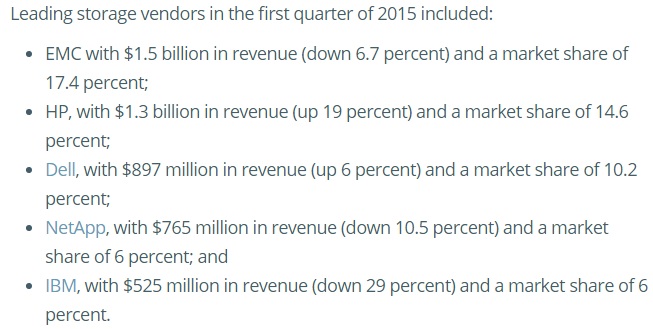
There is chatter about big purchases: the never-ending tale about EMC and HP, IBM is looking to buy CyberArk (maybe), Oracle bought Maxymiser, and CA completed their Xceedium deal.
As people are talking about purchases, SalesForce CEO Mark Benioff continues to talk smack about IBM and Oracle. Meanwhile, IBM expands their systems that can emulate organic thought process.
IBM
- IBM launches Linux-only mainframe system LinuxONE
IBM’s continued expanding support of Linux and Open Source projects makes sense given that these platforms and tools provide much of today’s connected infrastructure. And, the move away from in-house servers to cloud-based ones is a direct threat to IBM’s mainframe business. The company’s claim that it can provide a fast, reliable, and secure alternative at half the cost of cloud-based solutions is bound to get the attention of those with large-scale projects who want to control costs.
http://www.extremetech.com/computing/212410-can-ibms-linuxone-mainframe-compete-with-cloud-computing
- IBM Creates ‘Neuromorphic Chip’ That Is As Powerful As A Rodent’s Brain
The network that IBM unveiled today uses around 48 million connections, which is the same computing power as a rat’s brain. The system is designed to be able to run “deep-learning” algorithms, similar to the facial recognition system being used by Facebook or the instant translate mode in Skype. However, IBM’s deep-learning algorithms are much cheaper to run, draw less electricity and are not the size of an entire data center. TrueNorth essentially contains 5.4 billion transistors and uses a tiny 70 mw of power. As a comparison, an Intel processor with 1.4 billion transistors draws between 35 and 140 watts.
- Buffett Loves IBM. That’s Bad for Innovation, and Investors
IBM still develops many things, but not on the scale or with the profundity it did in decades past. It has been nurturing select investments for years, and pruning the losers. The company has shed multiple underperforming businesses in the past two decades, a tradition continued by current chief Virginia “Ginni” Rometty. First was the personal computer, a business it got out of in 2005, then last year’s sale of server computers based on Intel’s x86 chip, followed by this year’s divestiture of its chip-making operations.
http://www.barrons.com/articles/buffett-loves-ibm-thats-bad-for-tech-innovation-and-ibm-1439617268
- IBM and FireEye Possible Candidates to Acquire CyberArk, Centrify
http://www.thestreet.com/story/13260085/1/ibm-and-fireeye-possible-candidates-to-acquire-cyberark-centrify.html
EMC
- Why EMC’s ‘federation’ could unify (Yes, we are still talking about this)
EMC’s decision to control VMware but at arm’s length was brilliant. It allowed the faster-growing acquired company to trade at a much higher relative valuation than its parent. Now both companies are slowing, and at least one prominent Wall Street analyst believes EMC will bring all the companies into the fold. “A stand-alone EMC, a stand-alone VMware, and a stand-alone Pivotal would, in our opinion find it difficult to compete,” writes Maynard Um of Wells Fargo Securities . Whereas VMware thrived by selling to EMC competitors like HP and Cisco, those companies increasingly are competing with both companies now, removing one of the benefits of separation.
http://fortune.com/2015/08/19/emc-vmware-pivotal-federation/
- EMC management trio jump ship to competitors
Isabelle Guis, a product marketing VP and head of cloud strategy at EMC, joins Egnyte in September to become its chief strategy officer. Egnyte is a file sync ‘n sharer for enterprises, now saying it’s involved in adaptive enterprise file services. As such it competed with EMC’s Syncplicity business. This was sold to Skyview Capital in July. Syncplicity’s CEO in EMC days was Jeetu Patel. He moved to Box earlier this month to become an SVP and its chief strategy officer. These two moves, when added to that of EMC’s chief marketing officer Jonathan Martin, who went to a similar CMO spot at fierce EMC competitor Pure Storage in July, add up to… what exactly?
Oracle
- Oracle snags Maxymiser to goose its marketing push
Maxymiser specializes in what is called A/B testing, in which marketing professionals offer a couple of options to prospects to see which gets the best response. In theory, great A/B testing means that customers or would-be customers get pitches that actually interest them, rather than irritate them.
- The epic 30-year bromance of billionaire CEOs Larry Ellison and Marc Benioff
But their relationship took a quick turn in 2000 when Benioff found out that Oracle had secretly started its own CRM service that directly competed with Salesforce. Benioff wanted Ellison to leave Salesforce’s board immediately, but Ellison refused to quit. Ellison told Benioff, “It would be much cooler if you fired me.” (because that way Ellison would get to keep his Salesforce shares).
http://www.businessinsider.com/larry-ellison-marc-benioff-relationship-2015-8
- Adobe, IBM on top for enterprise digital marketing platforms; Oracle, Salesforce increasingly threaten
A new report by global analyst firm Ovum has found Adobe to be the overall market leader for digital marketing platforms, followed closely by IBM, Oracle, and Salesforce. SAS and Teradata are the market challengers and new market entrant Marketo is a follower. These vendors share three-quarters of the annual US$5bn global market spend on digital marketing platforms.
Hewlett Packard
- Why big data will be a big deal for the new HP
HP’s big data offerings fall under the umbrella of its Haven product, which includes the company’s Hadoop distribution (which it works with partners like Hortonworks to deliver), along with Vertica (a SQL analytics platform), IDOL (for analyzing unstructured data) and HP’s Distributed R (for large-scale predictive analytics).
http://www.networkworld.com/article/2973046/cloud-computing/why-big-data-will-be-a-big-deal-for-the-new-hp.html
Comment: This is a fine thing to say, but HP seems to be late to the party (really late). Do they have the ability to catch up and entice customers away from the other platforms? - HP CEO Whitman On The Odds Of A Blockbuster Acquisition And How HP Enterprise Stacks Up Against EMC, IBM
You never say never. But I think probably not. We are really pleased with our portfolio. We think we are incredibly well positioned. We have got some nice growth in our businesses. I would rather look to the future and what we are going to do on a go-forward basis. But you never say never. Who knows what is going to happen. We have been very disciplined, and we have been smart about it, and I think we have been on the right side of right so far. EMC looks a little bit more like HP, but they don’t have our big technology services arm and they don’t have our Enterprise Services arm. Listen, they have some great technology, but we are doing very well in storage. Our all-flash storage array was up 400 percent year-over-year. We are really cranking on all-flash storage array.
Other
- How the cloud will devour open source
Take MySQL, for example. The database has changed hands a few times, with Sun acquiring MySQL AB in 2008, then Oracle picking up the asset through its acquisition of Sun the following year. But MySQL, Sun, and Oracle have collectively made a heck of a lot less — orders of magnitude less — by selling MySQL-related services than Amazon Web Services has made by selling MySQL as a service (that is, Relational Database Service).
- Don’t be IBM! Benioff goads the ‘dinosaurs’ as Salesforce beats Wall St expectations
The way to understand the future is to look at the past, and you can look at IBM with the mainframe business. I think we all know IBM still sells a lot of mainframes. That doesn’t mean that IBM is innovating, that doesn’t mean that IBM is creating value for customers or helping them to transform customers’ businesses or align them with modern trends. It just means they’re selling them old technology and upgrading it. That’s what you see with companies like Oracle and SAP. These are old technology bases that are kind of meandering along like mainframes. And I think that is reflected in their license revenue growth, which has been poor, and then their movement to the cloud has been stunted because they don’t want to shift those customers into new models.
- CA Technologies Completes Acquisition of Xceedium, Inc.
With the transaction complete, CA offers customers a comprehensive, flexible solution for controlling and protecting IT administrator or other privileged user accounts from external attacks or insider mistakes and malicious misuse. The combined solution provides privileged identity controls at the server and the gateway to control access and action based on identity. The proxy-based, gateway approach from Xceedium also provides privileged identity control over cloud, on-premise, virtualised and hybrid IT environments, helping to protect the systems driving the application economy.
http://www.cso.com.au/mediareleases/25440/ca-technologies-completes-acquisition-of-xceedium/
Photo: Pete Slater, Flickr






